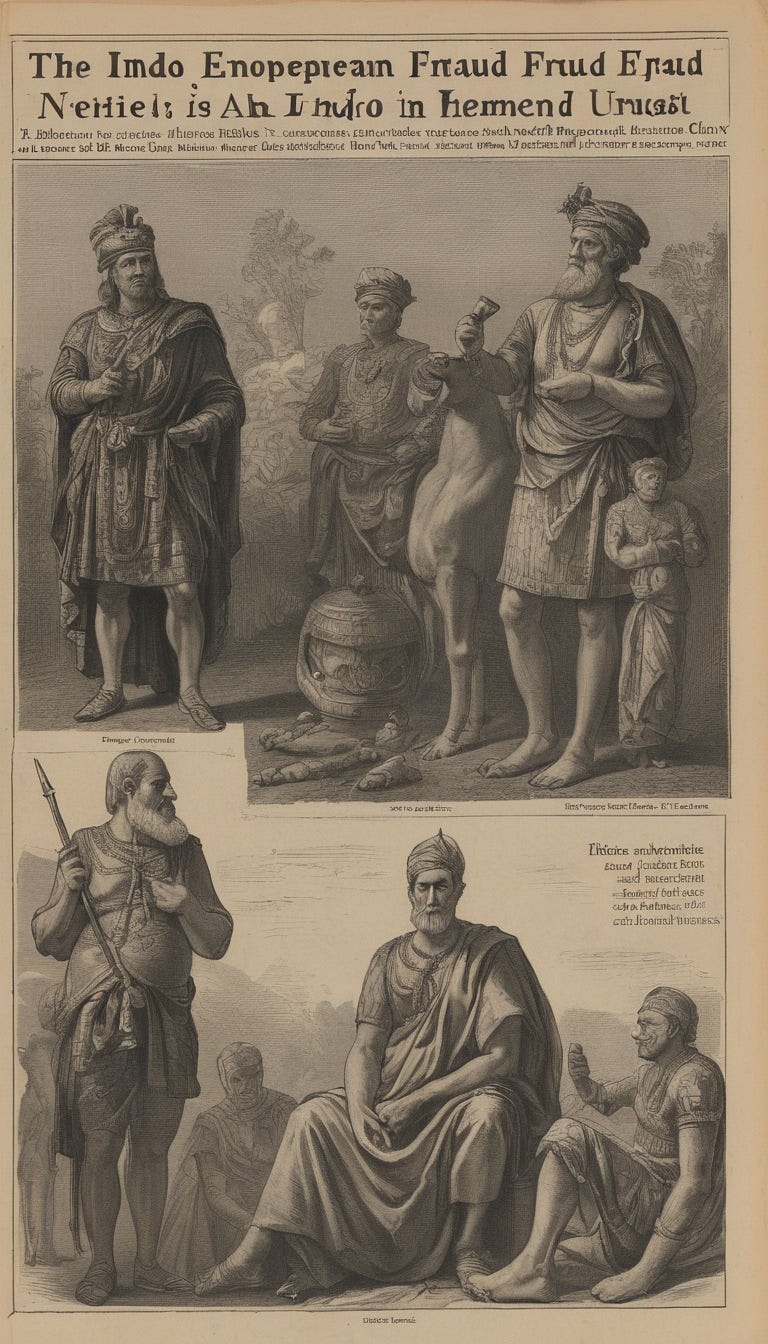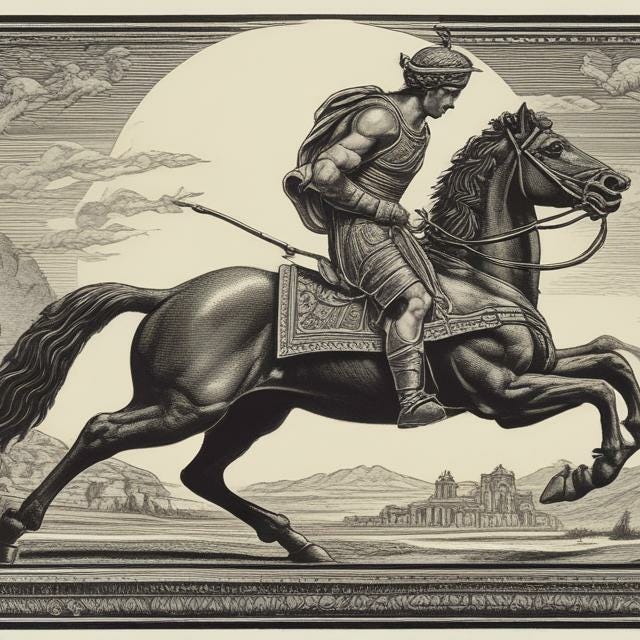The Indo-European Fraud
Debunking the Myth of a Common Ancestry
You can make one-off or recurring donations through Ko-Fi:
For centuries, the theory of an ancient Indo-European people—a widespread, unified group whose language gave rise to many of the modern languages of Europe, India, and beyond—has been accepted as a fundamental tenet of historical and linguistic scholarship. But when we dig deeper into the evidence, it becomes clear that this narrative is built on a foundation of speculation, gaps, and contradictions. The so-called Indo-European "supergroup" may well be a myth rather than a historical reality.
Let’s explore the major flaws in the Indo-European theory, from the lack of historical references to the absence of archaeological and anthropological evidence, and why this hypothesis cannot withstand scrutiny.
1. The Absence of Historical Evidence: A People Who Never Existed?
One of the most glaring issues with the Indo-European narrative is the total absence of any mention of "Indo-Europeans" in ancient historical records. From the writings of Herodotus to Byzantine historians, there is no reference to any such people. This is highly significant given the supposed vastness and influence of the Indo-European group. In fact, historians in antiquity were meticulous about cataloging various peoples—from the Egyptians and Assyrians to the Persians and Romans—but no one mentions the "Indo-Europeans."
Consider this: Diodorus Siculus and other writers speak about now-lost civilizations, including entire groups of people who vanished without a trace. Yet, the Indo-Europeans, supposed to have lived across vast regions of Europe, the Middle East, and Asia, are never recorded. If they were as large and influential as claimed, it is inconceivable that they would have escaped the attention of ancient historians.
The absence of any historical references to such a significant and widespread group strongly suggests that the Indo-Europeans, as a unified people, never existed.
2. A Lack of Archaeological Evidence: Where Are the Remains?
Perhaps the most compelling argument against the Indo-European hypothesis is the complete absence of archaeological evidence. Over centuries of excavation across Europe, Asia, and the Near East, no cities, monuments, or even small artifacts have been uncovered that can be definitively linked to the Indo-Europeans.
If these people were as widespread and influential as proposed, surely they would have left behind some tangible evidence. Where are the settlements, the buildings, or the everyday objects that should have survived? The truth is that no archaeological finds support the existence of this so-called Indo-European civilization. This lack of evidence underscores the implausibility of the Indo-European model. It is clear: if there was such a people, they left no trace.
3. The Absence of Anthropological Evidence: A Mythical Race
Just as there is no historical or archaeological evidence for the Indo-Europeans, there is also no anthropological evidence. No skeletal remains, no bones, no representations or depictions of these supposed people have ever been found. We have extensive anthropological records for civilizations like the Egyptians, Babylonians, and Persians, whose physical appearances have been documented in art and remains. Yet, no such records exist for the Indo-Europeans.
Anthropologists also point out that the idea of a single "Indo-European race" is biologically untenable. The vast differences in physical appearance between, say, the Greeks and the Indians, make it inconceivable that they could be descended from a single racial group. Instead of a unified "Indo-European" race, what we are dealing with are distinct peoples with their own unique histories, languages, and cultures.
4. Geography: Where Was the Homeland of the Indo-Europeans?
Another significant flaw in the Indo-European theory lies in geography. No ancient or modern geographer has ever identified a specific "Indo-European" homeland. Early proponents of the Indo-European theory have suggested locations ranging from the steppes of Russia to Anatolia, but these theories are at odds with each other. If the Indo-Europeans were such an important group, surely their homeland would have been identified by ancient geographers. But as it stands, the homeland of the Indo-Europeans remains an enigma.
Moreover, much of the territory where the Indo-Europeans are supposed to have lived, such as northern Europe and parts of Russia, was glaciated during the period in question. It is scientifically implausible that large groups of people could have inhabited these cold, inhospitable regions.
5. Linguistics: Similar Words Don’t Prove a Common Ancestry
One of the central arguments in favor of the Indo-European theory is linguistic similarities between languages like Greek, Latin, Sanskrit, and others. But the assumption that linguistic similarity equals shared ancestry is problematic. Words may resemble each other across languages due to contact or borrowing, but this doesn’t necessarily indicate a common ancestral people.
For example, linguists often point to similarities between the Greek word *patir* ("father") and the Latin *pater* or the German *Vater* as evidence of a shared Indo-European root. However, this comparison overlooks the fact that the Greeks were using patir (“πατήρ”) long before Latin or Germanic languages emerged. In fact, the Greek word is the origin of both pater and Vater —not the other way around.
Moreover, the comparison of disparate languages—such as Sanskrit and Greek—fails to account for the complex ways in which languages evolve over time. The theory of a single Indo-European "mother language" is built on shaky linguistic assumptions that ignore the more likely influence of Greek and other ancient languages on the development of later tongues.
6. The Problem of the Indo-European Language: Constructed from Thin Air
The core of the Indo-European theory lies in the concept of a hypothetical, reconstructed "Proto-Indo-European" language—a language no one has ever spoken or written down. The entire theory is based on linguistic reconstruction, with no concrete evidence to support it. How can scholars propose an entire grammar, syntax, and vocabulary for a language that has never been attested in writing?
Furthermore, there is no evidence that the Indo-Europeans ever used writing. No Indo-European texts have ever been found, and no script can be definitively linked to them. Yet, advocates of the Indo-European theory confidently build elaborate linguistic models, hypothesizing about the grammar and syntax of a language that never existed in the historical record. These theories are, at best, speculative exercises based on conjecture rather than hard evidence.
7. The Greek Exception: The True Source of Language and Culture
One of the most telling signs that the Indo-European theory is flawed is the role of the Greek language in shaping the languages of Europe and beyond. Greek has long been recognized as the language of philosophy, science, and the arts. Its influence on European languages is undeniable, and many modern languages have borrowed extensively from Greek vocabulary.
Yet, proponents of the Indo-European theory continue to downplay the importance of Greek. Why? Because acknowledging the Greek language as a central source of linguistic development would undermine the entire Indo-European model. Greek, with its ancient and unbroken tradition, has been the mother of many modern European languages. Instead of focusing on an invented "Proto-Indo-European" language, it is far more accurate to trace the roots of European languages to Greek, the true origin of much of the vocabulary and syntax we see in modern tongues.
Conclusion: The Indo-European Myth Unraveled
In conclusion, the theory of the Indo-Europeans is a flawed and unsubstantiated narrative. From the complete absence of historical, archaeological, and anthropological evidence, to the implausible linguistic theories that underpin the Indo-European hypothesis, it is clear that this "super-group" of people never existed.
Linguistic similarities do not prove shared ancestry. Ancient geographers and historians never recorded the Indo-Europeans, and their so-called homeland remains a mystery. Anthropologists have shown that the idea of a unified Indo-European race is biologically untenable. And as we examine the overwhelming influence of Greek language and culture on modern Europe, it becomes even more apparent that the Greek language, not some imagined Indo-European root, is the true source of many European languages.
The Indo-European theory, though once widely accepted, no longer holds up under scrutiny. It is time to move beyond this outdated narrative and recognize the diverse, complex histories of the peoples who shaped our world.
If you enjoyed this article, share it with your family, friends and colleagues, subscribe to receive more content and if you want to support my ongoing work, you can use the link below.
Please help support my work. 🙏
Source: Kostas Plevris: Deliberate mistakes: Advocates of the Indo-Europeans and the Phoenicians







My late father, a linqust and self proclaimed skeptic. How I would love to visit with him about this today.
How do you feel about the Hebrew is Greek theory by Joseph Yehda??? I am aware of his name so I am skeptical.